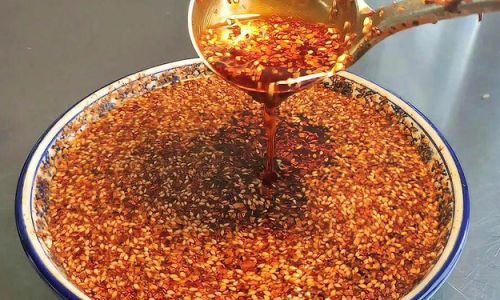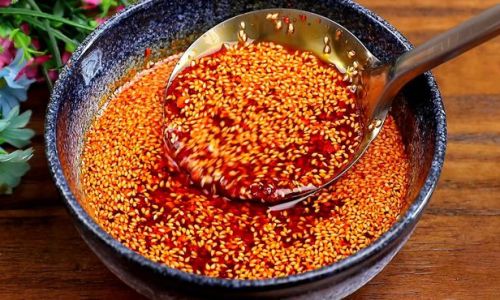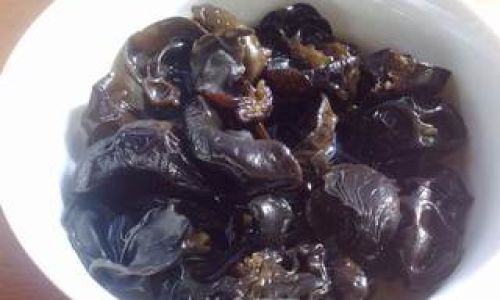Introduction

Chili oil, a staple in many cuisines across the globe, adds a fiery kick and a rich, aromatic flavor to dishes. Whether you’re drizzling it over noodles, dipping your dumplings, or using it as a marinade, chili oil can elevate any meal to new heights. But how do you make chili oil that’s not only fiery but also delicious, with a balanced flavor profile that lingers on your palate? This comprehensive guide will take you through the step-by-step process of crafting the perfect chili oil, from selecting the right ingredients to mastering the frying technique. By the end, you’ll be able to create a chili oil that’s as good as any you’d find in a restaurant.
Chapter 1: Understanding the Ingredients
Before diving into the recipe, it’s crucial to understand the role each ingredient plays in creating delicious chili oil. Here’s a breakdown of the essentials:
1 Chili Peppers
Chili peppers are the backbone of chili oil. The type of pepper you choose will determine the heat level and flavor profile of your final product. Here are some popular options:
- Arbol Chilies: Known for their bright red color and moderate heat, arbol chilies add a fiery kick without overwhelming the other flavors.
- Cayenne Peppers: These are very hot and have a subtle, earthy flavor. They’re great for those who love a lot of heat.
- Guajillo Chilies: These chilies are milder but offer a rich, fruity flavor with a hint of sweetness. They’re perfect for balancing out the heat.
- Sichuan Peppercorns: While not traditionally considered a chili pepper, Sichuan peppercorns add a unique, floral, and slightly numbing sensation to chili oil. They’re a must for authentic Sichuan-style chili oil.
2 Oil
The oil you use is equally important. It should be neutral in flavor to allow the chilies and other ingredients to shine. Here are some good choices:
- Vegetable Oil: Refined vegetable oils like canola or grapeseed oil have a high smoke point and neutral flavor, making them ideal for frying chilies.
- Peanut Oil: Peanut oil has a slightly nutty flavor that complements chili oil well. It’s also very stable at high temperatures.
- Sesame Oil: A small amount of toasted sesame oil can be added at the end for an extra layer of flavor. However, it’s not suitable for frying due to its low smoke point.
3 Aromatics
Aromatics add depth and complexity to chili oil. Common choices include:
- Garlic: Garlic brings a savory, umami-rich flavor that enhances the overall taste.
- Ginger: Fresh ginger adds a subtle sweetness and a hint of spice.
- Shallots or Onions: These add a caramelized sweetness that balances the heat.
- Green Onions or Scallions: These can be added at the end for a fresh, grassy note.
4 Seasonings
Seasonings like salt, sugar, and vinegar can help balance the flavors and bring out the best in your chili oil. A pinch of salt enhances the taste, while a small amount of sugar can help mitigate the heat and add a touch of sweetness. A splash of vinegar, such as rice vinegar or apple cider vinegar, can brighten the flavors and add a tangy note.
Chapter 2: Preparing the Ingredients
Now that you know what ingredients to use, let’s talk about how to prepare them.
1 Toasting the Chilies
Toasting chilies brings out their natural oils and intensifies their flavor. Here’s how to do it:
- Preheat your oven to 350°F (175°C) or set up a grill or stovetop for toasting.
- Spread the chilies in a single layer on a baking sheet or in a skillet.
- Toast until they darken slightly and become fragrant, about 5-10 minutes in the oven or 2-3 minutes per side on the stovetop. Be careful not to burn them, as this will make your chili oil bitter.
- Let the chilies cool, then remove the stems and seeds if desired. The seeds contain most of the heat, so removing them will reduce the chili oil’s spiciness.
2 Preparing the Aromatics
Finely chop the garlic, ginger, and shallots or onions. You want them to be small enough to release their flavors quickly when fried but not too fine that they burn easily.
Chapter 3: Making the Chili Oil
With your ingredients prepared, it’s time to make the chili oil. Here’s a detailed step-by-step recipe:
1 Combining Ingredients
In a large, heavy-bottomed pot or wok, pour in enough oil to fully submerge the chilies and aromatics. The exact amount will depend on how much chili oil you want to make. As a general rule, use about 3-4 times more oil than the combined weight of the chilies and aromatics.
2 Heating the Oil

Place the pot over medium-low heat. It’s important to use low heat to avoid burning the ingredients, which can make the chili oil bitter and ruin its flavor.
3 Adding Aromatics
Once the oil is warm, add the chopped aromatics. Let them cook gently, stirring occasionally, until they become fragrant and slightly golden, about 5-7 minutes. Be careful not to let them burn.
4 Adding the Chilies
Add the toasted chilies to the pot. Continue to cook, stirring occasionally, until the chilies darken further and the oil takes on a deep red color, about 10-15 minutes. The oil should be simmering gently, not bubbling vigorously.
5 Adjusting the Flavor
Taste the oil and adjust the seasoning as needed. If it’s too spicy, you can add a pinch of sugar or a splash of vinegar to balance it out. If it lacks flavor, you can add more aromatics or a touch of salt.
6 Finishing Touches
-
Once the chili oil has reached your desired flavor and color, remove it from the heat. Let it cool slightly, then strain out the solids using a fine-mesh sieve or cheesecloth. Press down on the solids to extract as much oil as possible.
-
If desired, you can add a small amount of toasted sesame oil to the strained chili oil for an extra layer of flavor. Be sure to do this while the oil is still warm so the flavors can meld together.
Chapter 4: Storing and Using Your Chili Oil
Now that you’ve made your delicious chili oil, here’s how to store and use it.
1 Storing Chili Oil
- Transfer the chili oil to a clean, airtight container.
- Store it in a cool, dark place away from direct sunlight.
- Chili oil can last for several months if stored properly. However, its flavor will be best within the first few weeks.
2 Using Chili Oil
- Chili oil is incredibly versatile. You can use it as a dipping sauce, a marinade, or a finishing oil for dishes like noodles, dumplings, stir-fries, and salads.
- Drizzle it over soups, stews, and grilled meats to add a fiery kick and a rich, aromatic flavor.
- Experiment with different chili pepper combinations and aromatics to create unique flavors tailored to your taste.
Chapter 5: Troubleshooting and Tips
Even the best chefs encounter issues when cooking. Here are some common troubleshooting tips and helpful hints for making delicious chili oil.
1 Preventing Burning
- The key to preventing burning is to use low heat and stir frequently. If the oil starts to smoke or the ingredients turn dark brown or black, you’ve gone too far.
- Keep a close eye on the chili oil as it cooks, and be prepared to adjust the heat if necessary.
2 Balancing Heat and Flavor
- If your chili oil is too spicy, you can add a pinch of sugar or a splash of vinegar to balance it out.
- If it lacks flavor, you can add more aromatics or a touch of salt. Remember, it’s better to err on the side of caution and add flavors gradually, tasting as you go.
3 Straining the Oil
- Make sure to strain the chili oil thoroughly to remove all the solids. This will give you a clearer, smoother oil with a cleaner flavor.
- Press down on the solids with the back of a spoon or a ladle to extract as much oil as possible.
4 Experimenting with Flavors
- Don’t be afraid to experiment with different chili peppers, aromatics, and seasonings. The combinations are endless, and you may discover a flavor profile that




0 comments